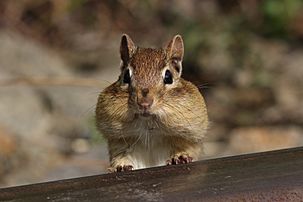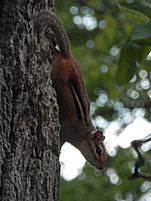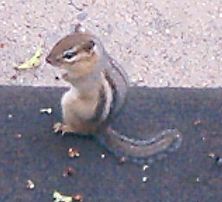Eastern chipmunk facts for kids
Quick facts for kids Eastern chipmunk |
|
|---|---|
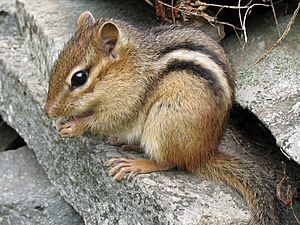 |
|
| Conservation status | |
| Scientific classification | |
| Genus: |
Tamias
|
| Species: |
striatus
|
| Subspecies | |
|
|
 |
|
| Synonyms | |
|
Sciurus striatus Linnaeus, 1758 |
|
The eastern chipmunk (Tamias striatus) is a small, striped chipmunk that lives in eastern North America. It's the only living member of its special group of chipmunks called Tamias.
Did you know the name "chipmunk" comes from a Native American language? It comes from the Ojibwe word ajidamoo. This word means "one who descends trees headlong," which is a perfect description for these quick little animals!
Contents
What Does an Eastern Chipmunk Look Like?
Eastern chipmunks are small animals. They grow to be about 30 centimeters (12 inches) long, including their tail. They usually weigh between 66 and 150 grams (2.3 to 5.3 ounces).
Their fur is reddish-brown on their upper body. They have five dark brown stripes that stand out against lighter brown stripes along their back. These stripes end at their dark tail. Their belly fur is lighter in color.
They also have a tan stripe that goes from their whiskers to below their ears. You can also see light stripes above their eyes. Eastern chipmunks have four toes on their front paws and five toes on their back paws.
Where Do Eastern Chipmunks Live?
Eastern chipmunks live in deciduous forests. These are forests where trees lose their leaves in the fall. You can find them across the eastern United States and southern Canada.
They also live in urban parks and even in your backyard! They like places with rocks, piles of logs, or bushes. These spots give them good places to hide and stay safe.
How Do Eastern Chipmunks Behave?
Eastern chipmunks are very good at climbing trees. But they actually build their homes underground! Their nests are part of a big system of tunnels. These tunnels often have many entrances.
To keep their homes a secret, chipmunks carry soil away in their cheek pouches. This way, no one sees where they are digging. They also line their burrows with leaves, rocks, and sticks. This makes their homes even harder to find.
Eastern chipmunks make several different sounds. Some sound like birds, while others are chattering calls. One call is a fast trill, and another is a lower clicking sound.
What Do Eastern Chipmunks Eat?
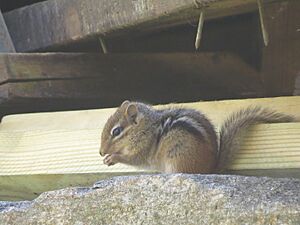
Eastern chipmunks are most active during the day. They spend a lot of their time looking for food. They love to eat bulbs, seeds, fruits, and nuts.
They also enjoy green plants, mushrooms, insects, worms, and even bird eggs. Like other chipmunks, they have special pouches in their cheeks. They use these pouches to carry lots of food back to their burrows!
Eastern Chipmunk Life Cycle
Eastern chipmunks are usually quite solitary. This means they live alone. They only spend time with other chipmunks during mating season.
Female chipmunks usually have one or two litters of babies each year. Each litter has about three to five young chipmunks. The two main breeding seasons are from February to April and from June to August.
During the winter, chipmunks might go into a long sleep called torpor. This is like a deep nap, but it's not true hibernation. They wake up sometimes to eat from their stored food.
Many animals hunt eastern chipmunks. These include hawks, owls, foxes, raccoons, snakes, weasels, coyotes, bobcats, and lynx. Even domestic dogs and domestic cats can be predators.
In the wild, eastern chipmunks usually live for three years or more. But if they live in captivity, like in a zoo, they can live as long as eight years!
Special Subspecies: T. s. doorsiensis
There's a special type of eastern chipmunk called Tamias striatus doorsiensis. This subspecies was first described in 1971. You can only find it in certain counties in northeastern Wisconsin, like Door and Kewaunee counties.
These chipmunks have brighter patches behind their ears. Their fur along their backs is grayer, and they have more white on their tails. They are smaller than some other eastern chipmunks but larger than the least chipmunk.
Gallery
-
Eastern chipmunk with filled cheek pouches, Cap Tourmente National Wildlife Area, Quebec, Canada
See also
 In Spanish: Ardilla listada del Este americano para niños
In Spanish: Ardilla listada del Este americano para niños



